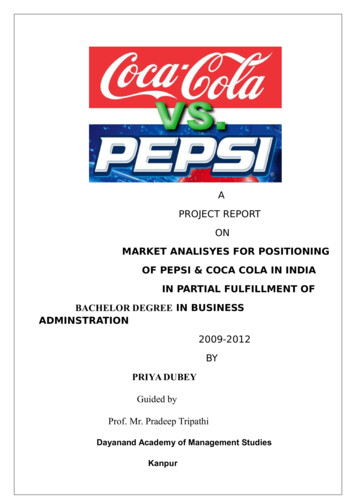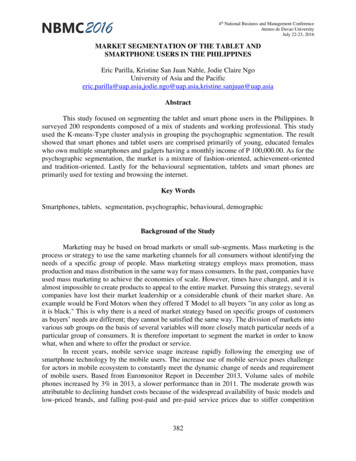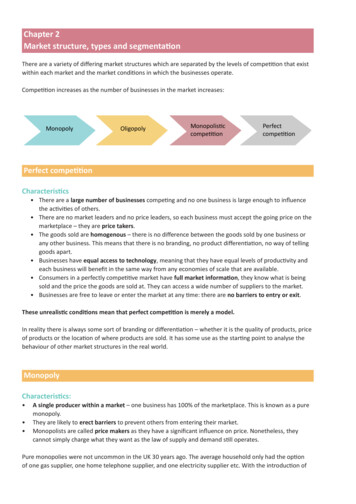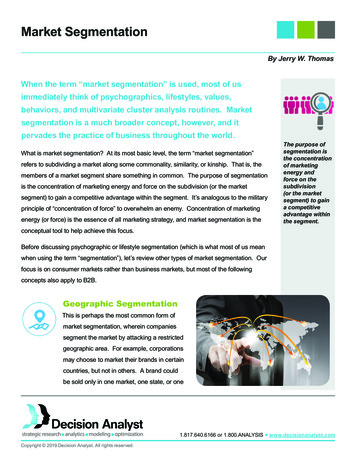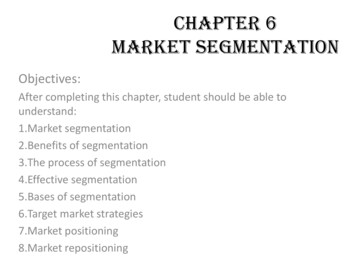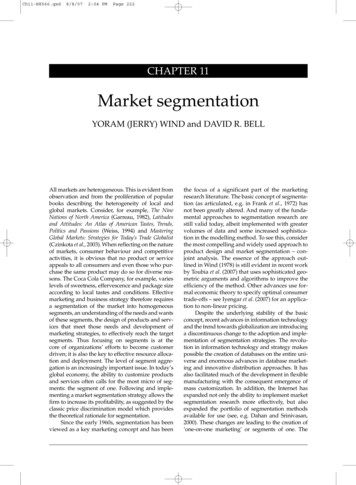
Transcription
Market Segmentation, Targeting, and Positioning Leonard Walletzký
SegmentationTargetingPositioningNázev prezentace v zápatíMarketing TP5CMarketing framework4P7P4C7C4S2
The STP ProcessSegmentation is the process of classifyingcustomers into groups which share some commoncharacteristicTargeting involves the process of evaluating eachsegments attractiveness and selecting one or moresegments to enterPositioning is arranging for a product to occupy aclear, distinctive and desirable place relative tocompeting products in the mind of the consumer
Target MarketA market is a set of all actual and potential buyersA target market is a group of people toward whoma firm markets its goods, services, or ideas with astrategy designed to satisfy their specific needsand preferences.Any marketing strategy must include a detailed(specific) description of this.
Advantages of SegmentationThe process of breaking up a homogeneous marketinto heterogeneous segments forces the marketerto analyse and consider both the needs of themarket and the company’s ability to competentlyserve those needs – thereby making the companybetter informed about its customers2. Competitor offerings and marketing positioningmust also be analysed in this context so thecompany must consider what its competitiveadvantages and disadvantages are, helping it toclarify its own positioning strategy3. Limited resources are used to best advantage,targeted at those segments that offer the bestpotential1.
Requirements for Effective SegmentationMeasurableAccessible Size, purchasing power, profilesof segments can be measured. Segments can be effectivelyreached and served.Substantial Segments are large orprofitable enough to serve.Differential Segments must responddifferently to different marketingmix elements & programs.Actionable Effective programs can bedesigned to attract and servethe segments.
Steps in Segmentation, Targeting, and Positioning6. Develop MarketingMix for Each Target Segment5. Develop Positioningfor Each Target Segment4. Select TargetSegment(s)3. Develop Selection Criteria2. Develop Profilesof Resulting Segments1. Identify Basesfor Segmenting the MarketMarketPositioningMarketTargetingMarket Segmentation
Step 1. Market SegmentationLevels of Market SegmentationMass MarketingSame product to all consumers(no segmentation)Segment MarketingDifferent products to one or more segments(some segmentation)Niche MarketingDifferent products to subgroups within segments(more segmentation)MicromarketingProducts to suit the tastes of individuals and locations(complete segmentation)Local MarketingIndividual MarketingTailoring brands/ promotionsto local customer groupsTailoring products/ programsto individual customers
Step 1. Market SegmentationBases for SegmentingConsumer MarketsGeographicNations, states,regions or citiesDemographicAge, gender, family sizeand life cycle,or incomePsychographicSocial class, lifestyle,or personalityBehaviouralOccasions, benefitssought, user status,usage rate, loyalty
Step 1. Market SegmentationBases for Segmenting Business mographicsBasesfor tingCharacteristics
Segmenting Business MarketsSegmentation by customer size or geographiclocationFour segments of business customersProgrammed buyersRelationship buyersTransaction buyersBargain hunters
Step 1. Market SegmentationBases for Segmenting International MarketsIndustrial termarket
Step 2. Market TargetingEvaluating Market Segments (developingselection criteria)Segment Size and GrowthAnalyze sales, growth rates and expected profitability forvarious segments.Segment Structural AttractivenessConsider effects of: Competitors, Availability of SubstituteProducts and, the Power of Buyers & Suppliers.Company Objectives and ResourcesCompany skills & resources relative to the segment(s).Look for Competitive Advantages.
Step 2. Market TargetingMarket Coverage StrategiesCompanyMarketingMixMarketA. Undifferentiated MarketingCompanyMarketing Mix 1CompanyMarketing Mix 2CompanyMarketing Mix 3Segment 1Segment 2Segment 3B. Differentiated MarketingCompanyMarketingMixSegment 1Segment 2Segment 3C. Concentrated Marketing
Step 2. Market TargetingChoosing a Market-Coverage ��s eting Strategies
Step 3. Positioning for CompetitiveAdvantageProduct’s Position - the way the product isdefined by consumers on importantattributes - the place the product occupiesin consumers’ minds relative to competingproducts.Marketers must:Plan positions to give their products the greatestadvantage in selected target markets,Design marketing mixes to create these plannedpositions.
Step 3. Positioning for CompetitiveAdvantage: StrategiesProductClassAway AAgainst aCompetitorDEBUser ClassFUsageOccasions
Steps to Choosing and Implementinga Positioning StrategyStep 1. Identifying Possible CompetitiveAdvantages: Competitive Differentiation.Step 2. Selecting the Right CompetitiveAdvantage: Unique Selling Proposition (USP).Step 3. Communicating and Delivering theChosen Position.Step 4. Support the positioning strategy with aunique marketing mix
Developing CompetitiveDifferentiationProductServiceAreas for CompetitiveDifferentiationImagePeople
Selecting the Right PromoteDistinctiveSuperiorCommunicable
Step 4 – Supporting the positioningstrategyAt this stage the company has decided on itspositioning strategy and must now design amarketing mix to support this strategy. The nextpart of the course looks at ‘Developing theMarketing Mix’
Select Target Segment(s) 5. Develop Positioning for Each Target Segment 6. Develop Marketing Mix for Each Target Segment Market Positioning Market Targeting Market Segmentation . Step 1. Market Segmentation Levels of Market Segmentation Mass Marketing Same product to all consumers (no segmentation) Segment Marketing Different products to one or more segments (some



